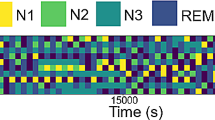Abstract
Deep sleep is a key part of the sleep cycle and plays a crucial role in the daily physical recovery process. Due to the complexity and lengthy process of collecting sleep EEG data in real life, which can also pose unnecessary inconvenience to subjects over long periods, we employed three data augmentation methods to enrich the dataset and introduce more variability under limited data capabilities. In this paper, we explore the application of data augmentation in classifying deep sleep stages by analyzing electroencephalogram (EEG) signals with Convolutional Neural Networks (CNNs). These strategies are designed to present the machine learning models with a broader range of sleep EEG signal features, thereby enhancing their ability to accurately identify deep sleep stages. The study employed three publicly available CNN models that are effective for sleep stage classification and utilizes the Sleep-EDF public dataset for validation. The research findings indicate that datasets augmented with the proposed techniques show higher classification accuracy across all models, confirming the effectiveness and potential of these data augmentation methods in the context of deep sleep stage identification.
Supported by JSPS KAKENHI 20H04249.
Access this chapter
Tax calculation will be finalised at checkout
Purchases are for personal use only
Similar content being viewed by others
References
Chen, R., Sui, L., Xia, M., Liu, J., Zhang, T., Cao, J.: Convolutional neural networks for deep sleep detection based on data augmentation. Int. J. Comput. Technol. 24, 1–13 (2024)
Barnes, C.M., Lucianetti, L., Bhave, D.P., Christian, M.S.: “You wouldn’t like me when I’m sleepy’’: leaders’ sleep, daily abusive supervision, and work unit engagement. Acad. Manag. J. 58(5), 1419–1437 (2015). https://doi.org/10.5465/amj.2013.1063
Teplan, M., et al.: Fundamentals of EEG measurement. Measur. Sci. Rev. 2(2), 1–11 (2002)
Michel, C.M., Murray, M.M.: Towards the utilization of EEG as a brain imaging tool. Neuroimage 61(2), 371–385 (2012). https://doi.org/10.1016/j.neuroimage.2011.12.039
Knoop, M.S., de Groot, E.R., Dudink, J.: Current ideas about the roles of rapid eye movement and non-rapid eye movement sleep in brain development. Acta Paediatr. 110(1), 36–44 (2021)
Carskadon, M.A., Dement, W.C., et al.: Normal human sleep: an overview. Princ. Pract. Sleep Med. 4(1), 13–23 (2005)
Ding, X., He, Q.: Energy-fluctuated multiscale feature learning with deep convnet for intelligent spindle bearing fault diagnosis. IEEE Trans. Instrum. Meas. 66(8), 1926–1935 (2017)
Pan, J., Sayrol, E., Giro-i-Nieto, X., McGuinness, K., O’Connor, N.E.: Shallow and deep convolutional networks for saliency prediction. In: Proceedings of the IEEE Conference on Computer Vision and Pattern Recognition, pp. 598–606 (2016)
Kim, S.-J., Lee, D.-H., Lee, S.-W.: Rethinking CNN architecture for enhancing decoding performance of motor imagery-based EEG signals. IEEE Access 10, 96984–96996 (2022)
Lawhern, V.J., Solon, A.J., Waytowich, N.R., Gordon, S.M., Hung, C.P., Lance, B.J.: EEGNet: a compact convolutional neural network for EEG-based brain-computer interfaces. J. Neural Eng. 15(5), 056013 (2018). https://doi.org/10.1088/1741-2552/aace8c
Cortes, C., Vapnik, V.: Support-vector networks. Mach. Learn. 20, 273–297 (1995). https://doi.org/10.1007/BF00994018
Guresen, E., Kayakutlu, G.: Definition of artificial neural networks with comparison to other networks. Procedia Comput. Sci. 3, 426–433 (2011). https://doi.org/10.1016/j.procs.2010.12.071
Ho, T.K.: Proceedings of 3rd International Conference on Document Analysis and Recognition, pp. 278–282. IEEE (1995)
Antoniou, A., Storkey, A., Edwards, H.: Data augmentation generative adversarial networks. arXiv preprint arXiv:1711.04340 (2017)
Kassam, S.A.: Signal Detection in Non-Gaussian Noise. Springer, Heidelberg (2012)
Kiranyaz, S., Avci, O., Abdeljaber, O., Ince, T., Gabbouj, M., Inman, D.J.: 1D convolutional neural networks and applications: a survey. Mech. Syst. Signal Process. 151, 107398 (2021)
Zhu, Y., Li, Y., Lu, J., Li, P.: EEGNet with ensemble learning to improve the cross-session classification of SSVEP based BCI from ear-EEG. IEEE Access 9, 15295–15303 (2021)
Anguita, D., Ghelardoni, L., Ghio, A., Oneto, L., Ridella, S., et al.: The ‘K’ in K-fold cross validation. In: ESANN, pp. 441–446 (2012)
Yadav, S., Shukla, S.: Analysis of k-fold cross-validation over hold-out validation on colossal datasets for quality classification. In: 2016 IEEE 6th International Conference on Advanced Computing (IACC), pp. 78–83 (2016)
Kemp, B., Zwinderman, A.H., Tuk, B., Kamphuisen, H.A.C., Oberye, J.J.L.: Analysis of a sleep-dependent neuronal feedback loop: the slow-wave microcontinuity of the EEG. IEEE Trans. Biomed. Eng. 47(9), 1185–1194 (2000). https://doi.org/10.1109/10.867928
Mourtazaev, M.S., Kemp, B., Zwinderman, A.H., Kamphuisen, H.A.C.: Age and gender affect different characteristics of slow waves in the sleep EEG. Sleep 18(7), 557–564 (1995). https://doi.org/10.1093/sleep/18.7.557
Kemp, B., Olivan, J.: European data format ‘plus’(EDF+), an EDF alike standard format for the exchange of physiological data. Clin. Neurophysiol. 114(9), 1755–1761 (2003). https://doi.org/10.1016/S1388-2457(03)00123-8
Acknowledgements
This work was supported by JSPS KAKENHI 20H04249.
Author information
Authors and Affiliations
Corresponding author
Editor information
Editors and Affiliations
Rights and permissions
Copyright information
© 2024 IFIP International Federation for Information Processing
About this paper
Cite this paper
Chen, R., Sui, L., Xia, M., Cao, J. (2024). Deep Sleep Recognition Based on CNNs and Data Augmentation. In: Maglogiannis, I., Iliadis, L., Macintyre, J., Avlonitis, M., Papaleonidas, A. (eds) Artificial Intelligence Applications and Innovations. AIAI 2024. IFIP Advances in Information and Communication Technology, vol 714. Springer, Cham. https://doi.org/10.1007/978-3-031-63223-5_1
Download citation
DOI: https://doi.org/10.1007/978-3-031-63223-5_1
Published:
Publisher Name: Springer, Cham
Print ISBN: 978-3-031-63222-8
Online ISBN: 978-3-031-63223-5
eBook Packages: Computer ScienceComputer Science (R0)





